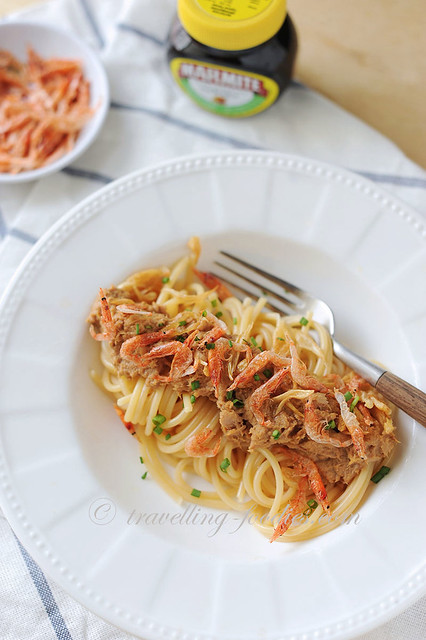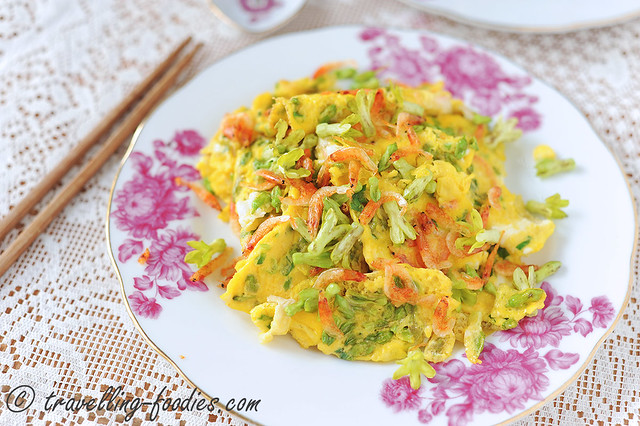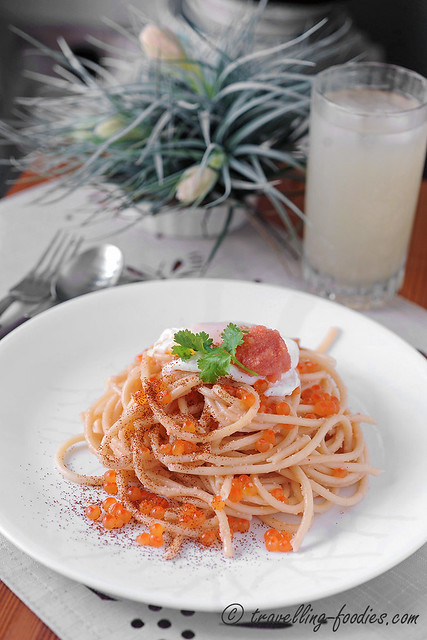Marmite Pasta ver.1 2017

The heat is excruciating to the point of being unbearable. But when one’s gotta eat, one’s gotta eat. There is of course the easy way out of running downstairs to the nearby coffeeshop to “tapao” but I seriously don’t wanna move an inch out in the sun. A few ingredients from the pantry and less than 30 min later, I have a quick and easy meal and for today its gonna be marmite pasta!
(more…)
夜香花樱花虾炒蛋 – Tonkin Jasmine & Sakura Ebi Omelette

Omelettes are a common dish on the dinner tables of many Chinese households. The versatility of the eggs, is like a clean canvas that provide us with endless possibilities for omelette dishes, each differing from the next. From Cantonese classics as elaborated as 桂花蛋 or 芙蓉蛋, to something as simple as a SPAM or an onion omelette, omelette dishes can also work to reflect the changing seasons, using ingredients that are only available during specific times of the year. To usher in the summer heat, 夜香花 Tonkin Jasmine bloom to exalt one and all in their perfumed blossoms and one can work it very nicely into an omelette as well ,together with sakura ebi, for a very refreshing 夜香花樱花虾炒蛋 – Tonkin Jasmine & Sakura Ebi Omelette.
海南炸猪排 Hainanese Fried Pork Chops – A Revisit

There are some dishes which I cook over and over again for my daily meals. Some of these are purely out of simplicity, allowing the laziness in me to take over, so that I don’t have to think to much or fuss over what to have for a weekday lunch. But some of these dishes are revisited over and over again because of the memories they carry. Many of these are comfort foods, dishes which I’d been eating all these years since young when my mother was still around. And now that she is gone, these dishes invoke a profound sense of nostalgia,reminiscent of the times we’d spent together cooking, the sights and sounds, not forgetting smells from our small kitchen. Thankfully over the years of cooking together, I’d learnt from her and consolidated a small but decent repertoire of dishes which we’d prepared together and enjoyed tremendously, dishes which I cook over and over again, archiving the flavours and fueling memories…
(more…)
On the Trail of the Phoenix – Telor Tempra

Those who know me well will know that I am an advocate of Peranakan home-cooking being approachable and simple, unlike what is typically heard and said about Straits Chinese cooking being laborious and tedious. While there are indeed dishes in the Baba Nyonya cuisine which are more painstaking to prepare, there is a repertoire of Peranakan dishes which require little time to cook and even less time to enjoy as they are so delicious, they are gobbled down in no time!
When I run out of ideas for what to prepare for a simple dinner, the ” tempra” sauce is my to-go-to style of Peranakan cooking which could be used with a wide variety of ingredients, all delicious and simple to prepare. No rempah to pound, no long hours of stewing, it usually manifest as “ikan tempra” or “ayam tempra” in our household but when I want something really fast and furiously done, “telor tempra” is most definitely the dish I would whip up as it requires just a bare few minutes from the chopping board to the dining table.
Fridge Drama, with Mentaiko, Ikura, Shrimp Roe and Poached Egg Pasta

There are those days when I feel so lazy to get out of the house to do anything. Well, make that most of the time *chuckles*. Yet we all have to eat yeah? So to compensate for those “lazy days”, I make sure that my fridge and pantry are well-stocked with ingredients which I may need to whip up something fast yet no less gratifying. As such, my fridge is always packed with food, and I often tell my friends that it is so stuffed that I have to be careful whenever I open it, or something would just drop out from somewhere. Friends laugh, dispensing it as a silly joke which I’d spun up but it’s true you know. Being a food hoarder comes with its own set of problems and fears. Some stuff are buried so deep within the abyss of other produce that they have to excavated. These “archaeological findings” usually take weeks and at times, months to be uncovered. Things which were once fresh turn stale and had to be binned. Wastage… But the greatest fear any food hoarder has is the day when the fridge decides to kick the bucket. That is sheer armageddon I tell you. And that happened to me just two weeks ago!
日向夏柑の寒天ゼリー Hyuganatsu Kanten Jelly

“Summer” is here again and for a tropical country like Singapore who knows no seasons, it is usually marked by unbearable heat waves, and hopefully late afternoon thunderstorms which help to dispel the heat for more tolerable nights, only to wake up to repeat this “daily cycle” all over again. While I loathe the heat, I love “summer” for several reasons and one of which is the coming of seasonal fruits we get only during this time of the year. Stone fruits take centre stage but not forgetting our lovely tropical mangoes and soon-to-come durians as well. One of my favorites is 日向夏柑 Hyuganatsu, a citrus from Miyazaki, Japan much loved for its refreshing sweet and sourish flavour combination. Amongst all the varieties of Japanese citrus available throughout the year from an assortment of different cultivars of Mikan to Yuzu, Kiyomi, Dekopon, Satsuma etc… Hyuganatsu is one which is particularly enjoyed to “welcome” the hot season, as the name of this citrus 夏 “natsu” literally means “summer” in Japanese. The Japanese love it and often present boxes of hyuganatsu as omiyage or gifts to friends, family and business associates whenever the fruits are in season. Though good to be eaten on its own, Hyuganatsu can also be used to make a variety of desserts, including the popular 日向夏柑の寒天ゼリー Hyuganatsu Kanten Jelly, which is so easy to make but incredibly enjoyable.
Iranian Shirazi Salad

Bearing strong contrast to many countries within the Arabian Peninsula which are characterised by inhabitable desserts, Iran is surprisingly quite well known for their vegetable and fruit produce. The first impressions of Iranian produce for me has to be their emerald green pistachios and saffron but more recently we saw other fruits like oranges imported from there as well. The local climate is particularly conducive for fruit and vegetable cultivation it seems. As such, fruits and greens form a large part of an Iranian diet and this can be seen through the variety of salads enjoyed by them. Amongst what I’d read on Persian cuisine, Salad-e Shirazi must surely be the easiest to prepare.
(more…)
Itadakimasu! – だし巻き玉子 Dashimaki Tamago

Sometime back, I can’t remember exactly when, I was told that the art of making tamagoyaki is the true litmus test to the “greatness” of a sushi chef. There are many things which a good sushi chef needs to master, i.e. his fish handling skills, his knife work, his sushi rice clasping technique, down to the proper way of toasting nori sheets… but a truly great sushi chef has to know his tamagoyaki well too! Well, I didn’t really buy it then. I mean… “how difficult could making tamagoyaki be?” I told myself. It was not until I attempted to make tamagoyaki on my own did I realise that yes indeed… not the easiest thing to do for sure. To make something which “looks like” tamagoyaki is manageable but to get all the ticks in texture, taste, colour, level of moisture, presentation etc… definitely requires quite a bit of dexterity. So this post is basically a little documentation of my experiments with the famed Japanese egg omelette (that is “omelet” for you guys in the US). I’ve not perfected it yet… no where near yet in fact.
(more…)
Itadakimasu! 蕎麦ぼうろ Soba Boro – Kyoto Buckwheat Cookies

When we were in Kyoto, we were intrigued by the variety of traditional Japanese snacks available in just one shop alone which we’d visited. It is a 老舗 shinise, which means that it has been around for a very long time, and the selection was far more extensive than what we would probably find in all the snack shops we’d seen elsewhere combined. Senbei and other forms of rice biscuits in all thinkable Japanese-inspired flavours from the savory sansho and sakura-ebi to sweet ones like kurogoma and matcha. But this comes as no surprise of course. Kyoto is the old capital of Japan for more than 1000 years. Many of these snacks have their roots deep in the art of 和菓子 wagashi, the traditional artform of Japanese sweet-making. But some of these are classified as 南蛮菓子 nanban-gashi, brought into Japan by the Spanish and Portuguese missionaries more than 500 years ago. The most famous of these “imported confectioneries” must surely be the カステラケーキ kasutera cake which was derived from the Portuguese “Pão de Castela”. It has since become a speciality of Nagasaki. Another lesser known confection which is essentially a nanban-gashi as well, is a cookie known as そばぼうろ Soba Boro, These have since become a popular snack which is synonymously associated to Kyoto, where visitors would buy packets of them home as omiyage. But the recipe is fairly straightforward, so now you can make them on your own as well!
(more…)
姜汁撞奶 Ginger Milk Pudding
We love to have desserts whenever we are in Hong Kong. The Cantonese folks are very much dessert lovers like us, and they are extremely well-known for their assortment of 糖水 “tong shueis” which are both delicious and therapeutic at the same time. The desserts are available all year around, with a menu that changes with the seasons. Summer welcomes the ice blends and chilled items, most notably being 楊枝甘露 Mango Pomelo Sago which is immensely popular especially with the young to combat the heat. For those who are looking for more traditional desserts, there is 南北杏木瓜炖雪耳 Double-boiled White Jelly Fungus with Papaya which is not only sweet, but boast to have a hoard of beneficial properties like soothing the throat and clearing phlegm. As the weather turns cold, the hot desserts become immensely popular, be it the “paste-based” desserts like 芝麻糊 sesame paste, 花生糊 peanut paste, 核桃糊 walnut paste, 杏仁糊 almond paste or even a simple bowl of 番薯姜汤 ginger soup and sweet potatoes with 汤圆 glutinous rice dumplings to warm the tummy.
As such, dessert parlours and tong shuei stalls are found literally everywhere in Hong Kong. Strange it may sound however, one of the places to enjoy these sweet numbers is not at dessert joints like 許留山 Hui Lau San and 大良八記 Dai Leung Pak Kee, but at 牛奶公司 “dairy companies”. And to further bewilder the already perplexed, these “dairy companies” do not produce milk but are actually tea shops or cafes affectionately known to the locals as 茶餐厅 “cha tzan teng“. Now are you confused already?
(more…)
On the Trail of the Phoenix – Kerabu Belimbing Timun Nanas (Nyonya Spicy Fruit Salad)

When I first started learning to cook nonya dishes, I remember being immediately overwhelmed by the sheer complexity of some recipes. Tedious steps to follow, long and painstaking preparation, tiring rempah pounding, long list of ingredients to garner… are just some of the reasons which deterred many from trying to cook the dishes for themselves. Yes, peranakan cooking can be very patience-testing, obviously one of the many virtues I lack. But the results are often very rewarding, as its through these multi-step culinary “ordeals” that all those intricate nuances of flavours and textures were teased out, to which is what many of us enjoy about peranakan cooking.
Having said that, not all peranakan dishes are difficult to cook or troublesome to put together. Kerabu Belimbing Timum Nanas is one such recipe which is almost effortless to prepare and requires very little time to do so. It is served as a “palate refreshener”, marking contrast against the other robust and full-bodied flavour dishes, to make the latter lighter for the stomach, so that the whole meal would not be just about heft. Being spicy and tart at the same time, it is perfect “conditoner” to whet everyone’s appetites!
煲仔鸡饭 Cantonese Claypot Chicken Rice
We used to have an eathern stove at home when I was young, fueled by charcoal that could be kept warm for hours, as the hardened chunks of ebony slowly wasted away to become a crumbly ivory, until all that’s left was a disintegrated heap of cinder and ash. But using it could be quite a hassle to use, especially to kickstart the burning. But me ain’t no boy scout, so it was usually my father who “did the honours” to get the fire started. Once started, it served for a myriad of purposes, i.e. toasting belachan (fermentted shrimp paste) to make sambal, maintaining a large pot of broth for steamboat refills, or simply transferring out the charcoal pieces from that stove into a longish rectangular metal trough which was used to prepare kueh belandah (nyonya egg rolls) for chinese new year . In fact, steamboats in the past where fueled by charcoal which were “preheated” using the earthern stove as well! While some of the uses of an earthen stove were somewhat ritualistic, others remained very practical, and for me, the most practical and personal favorite “use” of the earthern stove has to be cooking 煲仔鸡饭 Cantonese Claypot Chicken Rice!
Sadaharu Aoki’s Financier au Mâcha Salè 青木定治のフィナンシェオ抹茶

Sadaharu Aoki, a name that is prominently featured in my blog. Yes, I’m a big fan of his work, and more so, his determination and perseverance to excel and be the best. Not an easy feat, especially for a Japanese who didn’t speak a word of French when he first landed in Paris at the age of 21 more than 20 years back But he was determined to make it big and went through a lot to bring himself to the level of international recognition and fame which he enjoys today. When his contemporaries like Hidemi Sugino and Hideki Kawamura chose to remain in Japan after winning international pastry competitions like Coupe du Monde, Aoki made his base in Paris instead. Seemingly what a Don Quixote would do, most would think, to make a name for himself in the epicentre of pastry making, where so many others have failed. The odds of succeeding were slim but that challenge suited him best. An urban fairytale for any pastry lover…
On the Trail of the Phoenix – Sambal Udang Belimbing

Peranakans love cooking with fruits, spanning from the usual tropical varieties like pineapple in Sambal Nanas to durian in Apam Balik and banana in Pengat, to using more exotic varieties in lesser prepared dishes like young jackfruit in Sayur Nangka Masak Lemak, banana blossom in Kerabu Jantung Pisang and unripe papaya in Buah Paya Masak Titek. Some fruits are used almost exclusively in culinary cuisines from this region, and buah belimbing is one such fruit.
(more…)
Marron Glacé

I had the good fortune of getting hold of some really big and fat chestnuts recently, not to mention being able to hand choose the plump and round ones myself! A right start for making myself some marron glacé!
(more…)




